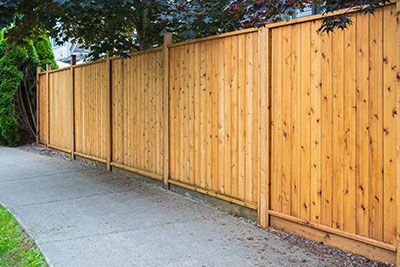13 Tips On How To Maintain A Wood Fence

A wood fence does more than mark a property line. It creates privacy, secures kids and pets, and adds charm to a home. But wood is a natural material. It reacts to water, sun, and soil. Without care, it breaks down.
Homeowners who learn how to maintain a wood fence protect their investment and extend its life. Proper upkeep saves money, adds beauty, and keeps the yard safe for years.
Choose the Right Wood From the Start
The life of a wood fence begins with the material itself. Cedar and redwood resist rot better than other types of wood. These woods may not be as strong as structural lumber, but they withstand weather well. Pressure-treated posts are also recommended since they sit in the ground. Posts without treatment are exposed to insects and moisture, which shortens their lifespan.
When planning a fence, it is worth asking about the type of wood used. Choosing quality materials reduces the need for repairs later. Even the best care cannot fix wood that starts weak. At Virtue Fence Company, wood fencing options are carefully selected to balance beauty with durability. Learn more about wood fencing available to homeowners looking for long-term value.
Seal the Surface
Water is the main enemy of wood. When water enters, it causes swelling, splitting, and rot. Applying a sealant helps stop this process. A clear preservative or stain penetrates the surface and blocks moisture from entering. Many homeowners choose a stain that also adds color, helping the fence match the house or yard.
Sealing is not a one-time job. The surface should be resealed every two to three years. Waiting too long allows water to soak in. A small investment of time with a brush or sprayer saves the fence from major damage down the road.
Give Posts Special Attention
Posts are the foundation of any fence. They are also the most exposed since they sit in soil and stay damp. Pressure-treated posts reduce the risk of rot, but extra care is still needed. Keep the soil from climbing up the post too high. When dirt covers more of the wood, it stays wet longer.
Homeowners can add gravel around the base to improve drainage. Gravel lets water flow away instead of pooling. This simple step extends the life of posts and helps the fence stay upright. Neglecting the posts often leads to leaning sections and costly repairs.
Keep Sprinklers Away
A sprinkler may keep the lawn green, but it is harmful to the wood. Repeated spraying soaks the fence every day, and water damage builds over time. Constant moisture invites rot, even on wood that was sealed. It also leaves marks that change the appearance of the boards.
Adjusting sprinklers so they avoid the fence makes a big difference. This is often a small change, but it saves years on the fence’s life. Protecting wood from direct, daily water is one of the easiest maintenance steps.
Clear Vines and Bushes
Plants look nice growing near a fence, but they carry hidden risks. Vines and bushes press against wood, holding moisture in place. Over time, this weakens boards and causes rot. Heavy vines also add weight that stresses the structure.
Leaving space between landscaping and the fence prevents these problems. Trim back branches and cut vines before they attach. A fence that can dry fully after rain will always last longer than one smothered in plants.
Watch for Early Signs of Damage
Small cracks and warps may not look serious at first, but they grow worse when ignored. Wood expands and contracts as it absorbs water and dries. A board that splits a little in one year may break in half the next.
Make it a habit to walk the fence line once or twice a year. Look for split boards, loose nails, or sagging sections. Repairing problems while they are small prevents expensive replacements later. Early action keeps the entire structure stronger.
Keep Hardware Tight
Wood is not the only part of the fence that needs care. Nails, screws, and hinges hold everything together. Over time, these pieces loosen as wood shifts. Loose hardware weakens panels and gates, leading to more movement and stress.
Check fasteners during seasonal inspections. Tighten screws and replace rusty pieces. Stainless steel or coated hardware resists rust and is worth the upgrade. A fence that is strong at every joint will last far longer.
Protect Against Insects
Insects, especially termites, can cause major damage to wood. They eat through boards and posts, hollowing them out from the inside. Homeowners may not notice until sections start to collapse. Regular inspection helps spot the warning signs early.
If insects are present, replace affected boards and consider treatment options. Sealing wood also helps by limiting exposed entry points. Preventing insect damage is far easier than repairing it after the fact.
Limit Soil and Mulch Contact
Many homeowners like to place mulch against a fence for a clean look. Unfortunately, mulch traps moisture. When mulch sits high against boards, it creates the perfect environment for rot. Soil has the same effect, especially after rain.
Keep a small gap between the bottom of the fence and soil or mulch. This gap allows air to circulate and wood to dry. A fence that stays dry near the ground will resist decay much better than one buried under damp material.
Stain for Style and Strength
A stain does more than change color. It adds another layer of protection. Unlike paint, stain soaks into wood fibers. This keeps the natural grain visible while helping block moisture. Stain also guards against sun damage, which fades and weakens wood.
Choose a color that complements the home and yard. Refreshing the stain every few years keeps the fence looking new. It also preserves strength, which is just as important as appearance.
Know When to Repair or Replace
No fence lasts forever. Even with the best care, boards may warp, posts may lean, and gates may sag. The key is knowing when a repair is enough and when replacement makes more sense.
Replacing one or two boards is often simple. But if many sections lean or rot spreads widely, it may be time for a new fence. Homeowners can consult a trusted residential fence installer in New Jersey for honest advice. Knowing the difference saves money and protects the property.
Inspect After Major Storms
High winds, heavy rain, or snowstorms put stress on wood fences. After a storm, walk the perimeter and check for damage. Look for leaning posts, fallen branches, or sections pushed out of alignment.
Quick action after a storm keeps small issues from growing. Straightening a post or removing debris right away prevents long-term damage. Storm inspections should become part of routine fence care, especially in areas with harsh weather.
Clean the Fence Regularly
Dirt, pollen, and mildew slowly build up on wood, especially in shaded or damp areas. Over time, this grime traps moisture and weakens the surface. A dirty fence also makes a yard look neglected, even if the structure is still solid.
Washing the fence once a year restores its appearance and helps it last longer. A garden hose with a spray nozzle is usually enough. For tougher spots, use a soft brush and mild soap. Avoid high-pressure washers since they can damage the wood fibers.
Protect Fence During Winter Months
Snow and ice cause major stress on wood. Moisture seeps in, freezes, and expands, leading to cracks. Heavy snow can also weigh down panels or push against posts. Winter is one of the toughest seasons for a fence.
Clear snow away from the bottom of the fence whenever possible. Avoid piling shoveled snow against panels since it traps moisture. Applying a fresh coat of sealant before winter also adds extra defense. Preparing before cold weather hits can save major repairs in spring.
Ready to Protect Your Fence Investment?
At Virtue Fence Company, we understand how to maintain a wood fence so it lasts. We guide homeowners through options, installation, and long-term care. Our team is dedicated to fences that look great and stand strong.
Contact us to discuss a fence project that fits your lifestyle and adds lasting value.

